Vítor Bruno’s tactical approach with FC Porto has brought a new layer of sophistication to the club’s gameplay. Known for his innovative and adaptive strategies, Bruno has fine-tuned Porto’s tactics to maximize both defensive solidity and attacking fluidity. By implementing flexible formations and a proactive pressing style, Bruno has redefined how Porto controls the field, crafting a team that’s as resilient as it is dynamic. This analysis explores the strategic principles and key tactical shifts that define Bruno’s FC Porto, shedding light on how these elements shape their performance on the pitch.
Build-up
Low Build-up
In the low build-up, Vítor Bruno usually sets his team up in an asymmetrical 1-4-2-2-2 formation, with a back four, two holding midfielders, two attacking midfielders, a striker, and a left-winger.

The seven building players will work together to beat the initial press and the four attackers will cooperate to create goalscoring opportunities. Bruno mainly wants to beat the press by finding an attacking midfielder in the space between the opposition’s defense and midfield, who can bounce the ball to a holding midfielder, who then can progress the ball forward.

When Porto beat the press, the attackers will immediately make runs in behind, looking to quickly exploit the holes in the opposition’s backline.

The Porto players are also not afraid to be more direct in the low build-up. If the opposition comes up and presses man-to-man, there will be numerical equality up top with Porto’s attackers against the opposition defenders. The goalkeeper will sometimes find an early longer ball up to the attackers, aiming to win 4v4 or 3v3 situations. The Porto attackers have good individual quality and will often win these battles to create goalscoring opportunities.

High Build-up
In the high build-up, Bruno’s Porto usually uses the 1-4-2-3-1 formation, with a back four, two holding midfielders, a number-ten, two wingers, and a striker up top.

In Porto’s 1-4-2-3-1 attacking system, the wingers invert into the middle, meaning the fullbacks play a crucial role in providing width and supporting the attack by pushing up the field. When the wingers drift into central spaces, Porto’s fullbacks move higher up the flanks to occupy the vacated wide areas, giving the team multiple options in attack.


This positioning allows the fullbacks to either support the midfield with additional passing outlets or to exploit open channels for overlapping runs. By doing so, they draw defenders out of position, opening up space for the inverted wingers or central midfielders to make forward runs.
When advancing the ball, Porto’s holding midfielders and defenders will often find the attacking fullbacks in the spaces outside the opposition defense with precise through-balls. In these positions, the Porto fullbacks will have enough time and space to take the ball forward and cross it into the attackers in the box.


With the fullbacks pushing up, Porto’s structure will look more like a 1-2-2-5-1 formation with many players high up the pitch.
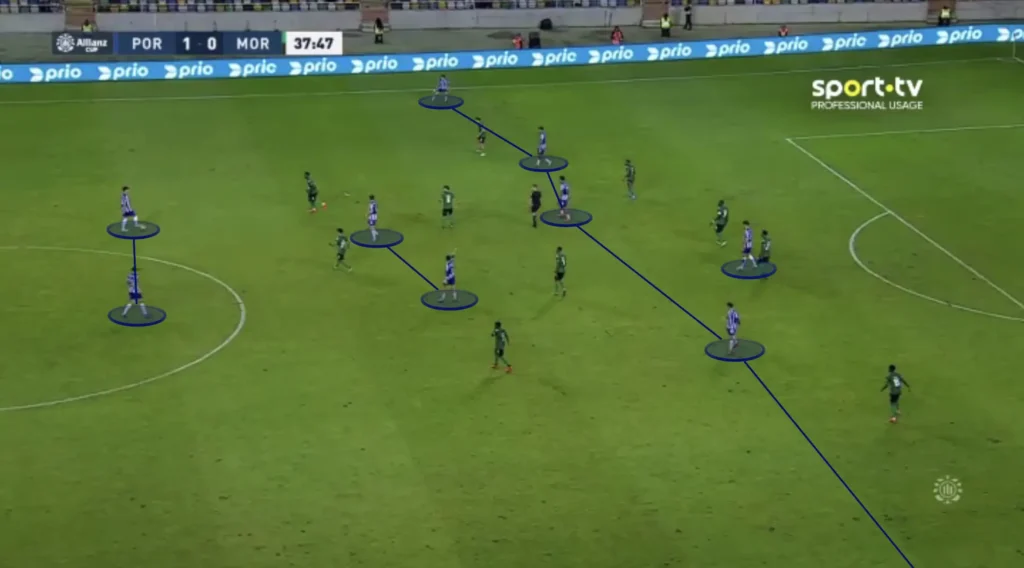

Rotations and Fluidity
The Porto players constantly rotate during the build-up. The team adopts a dynamic approach, shifting between formations to create numerical advantages and exploit spaces. Vítor Bruno’s focus is always to get the players into their best positions, where they can make the most out of their individual skills. He emphasizes versatility, with players interchanging positions seamlessly to maintain possession and disrupt the opposition’s defensive structure. This flexibility creates numerical superiorities in different areas, allowing Porto to bypass the opposition’s press while maintaining control.
Their most common rotation is to drop one of the holding midfielders into the backline. This shift creates a back three, allowing them to maintain defensive stability while gaining more control in possession.

By doing this, Porto not only widen the field but also open up different angles for passing, making it easier to beat the opposition’s press.
Numerical Advantages in the Middle
Regardless of the structure, Porto will have many players in the center. Bruno usually has the fullbacks wide on each side and positions the remaining eight players in the middle.
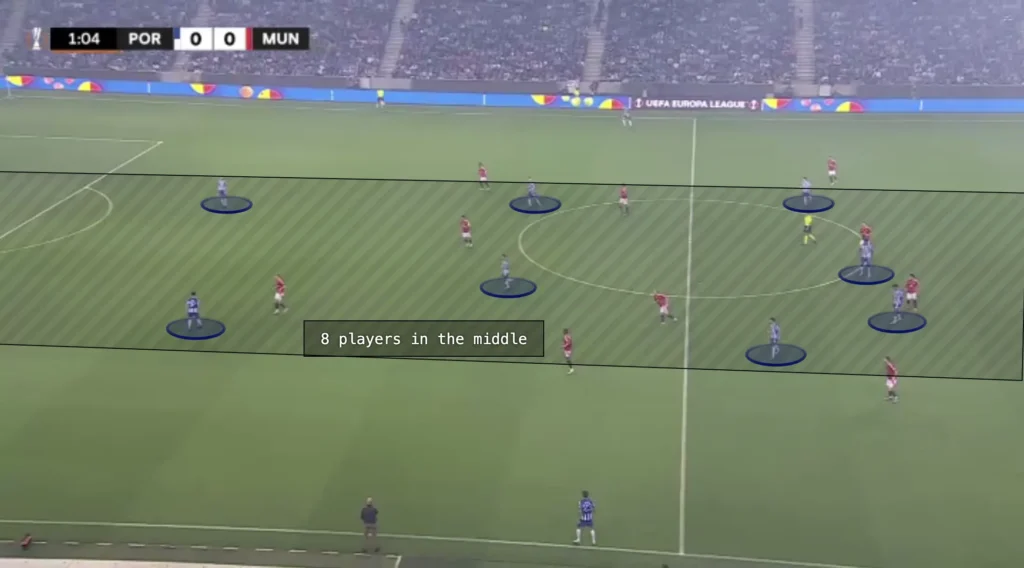
Having only the two fullbacks out wide and the rest of the players in the middle creates more options in the center and less space between the players. Bruno likes this because he prioritizes playing through the middle. He needs one player out wide to pull the opposition apart while the rest create numerical advantages in the midfield areas. When a team outnumbers the opposition in the midfield, it can more easily retain the ball, exploit spaces, and progress the ball through the center. Porto will often progress the ball through quick central passes between the midfielders, beating the opposition’s press and exploiting gaps in the defense. At the same time, having many players centrally builds good conditions in defensive transitions since it allows more players to counterpress when they lose the ball.
Another purpose for keeping many players in the middle is to shorten the distance between them. This shortens the length of the passes, which naturally shortens the time between passes. This means the opposition players will have less time to push up and press, giving the Porto players more time and control.
Finding the Pockets
Porto’s players always try to find the inverted wingers and number-ten in the pockets. These “pockets” refer to the spaces between the opposition’s defensive and midfield lines, where the number-ten and wingers can receive the ball in more advanced positions.
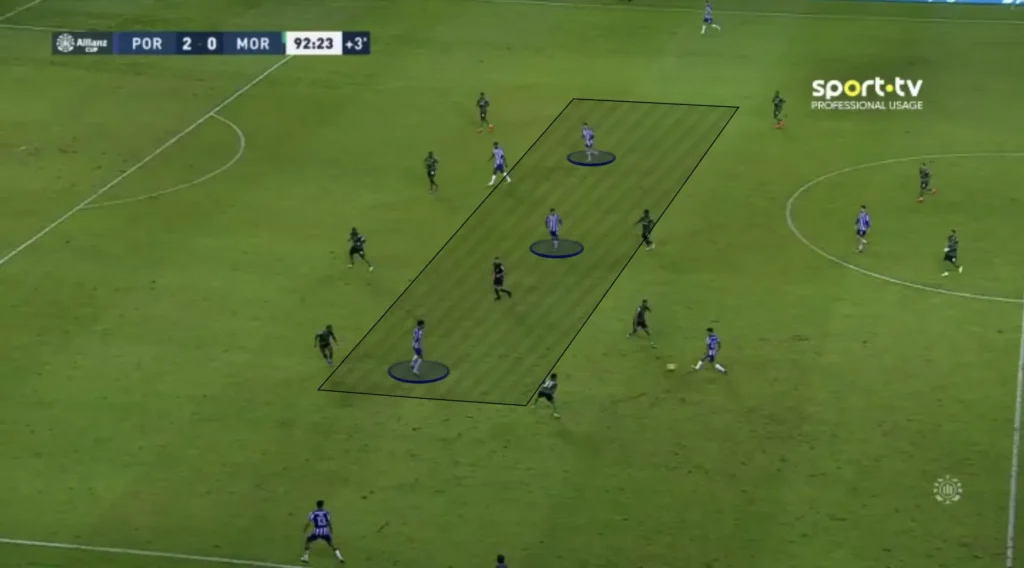
By positioning themselves intelligently in these pockets, the number-ten and wingers can turn quickly and face the opposition’s goal, creating opportunities for through balls, driving runs, or direct shots. This positioning forces the opposition to make difficult decisions. If an opposition defender steps up and closes down the Porto player, he potentially leaves space behind. If he stays back, he allows the number-ten/winger time on the ball. The Porto defenders and holding midfielders will look for straight passes, breaking the opposition lines and finding the number-ten or wingers who can turn and drive at the defense.

Finding these pockets is crucial for maintaining fluidity in attack and ensuring that the team can progress the ball effectively through the middle of the pitch.
Balls in Behind
The Porto attackers consistently make aggressive runs in behind the opposition defense when the fullbacks receive the ball. This movement is a key aspect of their offensive strategy, designed to stretch the defensive line and create space. As the fullbacks advance, the forwards will run in behind the opposition backline, exploiting gaps between defenders and allowing themselves to receive well-placed through-balls. The coordination between the fullbacks and attackers makes Porto’s offense unpredictable and difficult to defend against.
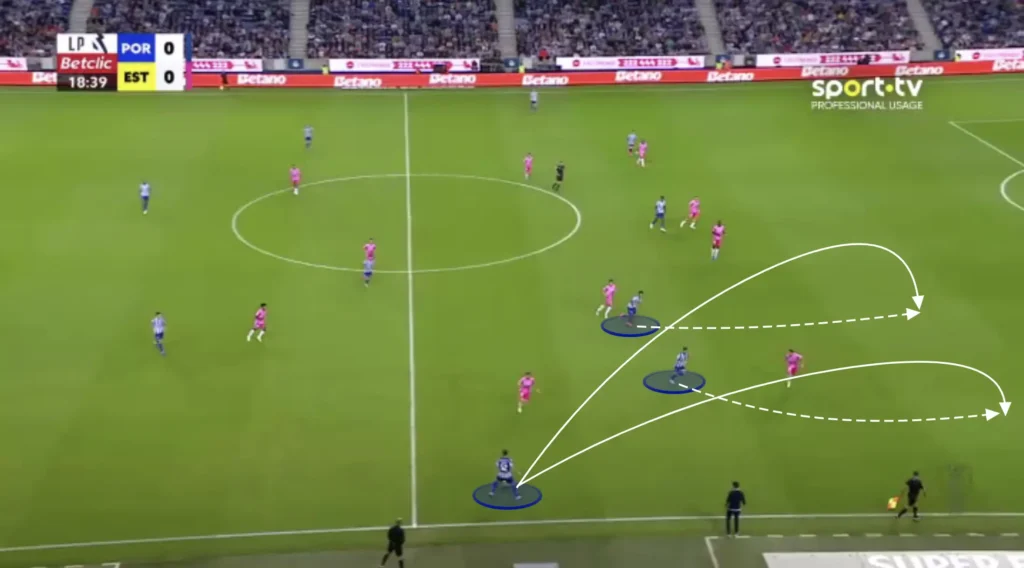

Additionally, this constant threat prevents the opposition from playing with a high backline and closing the space between the lines. Instead, they have to drop the backline and protect the space in behind. This opens the space in front of the backline for the Porto midfielders to exploit.
Counter-Movements
The Porto attackers will also use counter-movements to make it even more difficult for the opposition defenders. When one attacker makes the run in behind, another one will often drop. This forces the opposition center-backs to make a decision. If they step up on the dropping attacker, the space behind them opens up, allowing Porto to play a through-ball to the attacker who is making the run in behind. However, if they stay in the backline to cover the run, the ball can be played to the dropping attacker, who can turn and attack the defense.

Numerical Advantages Against the Opposition’s Defense
A massive aspect of Porto’s high build-up is their ability to create numerical advantages against the opposition’s defensive line. When the fullbacks push high up the pitch, they essentially add extra bodies to Porto’s forward line, forcing the opposition’s backline into difficult situations. This movement increases the number of attackers, and as a result, Porto can overload the defense, creating gaps for their attackers to exploit.
Bruno’s players mainly exploit this overload by creating 2v1 situations against the opposition fullback. These 2v1 situations will usually be found when Porto use quick switches of play. When the defending team is positioned on one side, the weak-side fullback becomes vulnerable to the switch of play due to the 1v2 against Porto’s inverted winger and attacking fullback. The inverted winger will often make a run in behind, which the defending opposition fullback will follow. This opens the space out wide for Porto’s attacking fullback. Bruno’s team often capitalizes on this by getting the ball to the fullback out wide and creating many opportunities from 2v1 situations on the wing and in the half-spaces.

Final Third
Attacking the Half-Space
Bruno’s players usually look to create chances by attacking the space between the opposition center-back and fullback. They primarily do this from the wide areas with underlaps from the inverted wingers. When the Porto fullback receives the ball out wide, he will attract the opposition fullback. This opens the space between the opposition fullback and center-back, which allows Porto’s inverted winger to make the underlapping run into this space. The ball can be played to the underlapping player, who can cross the ball into the box or attack his defender in a 1v1 situation.
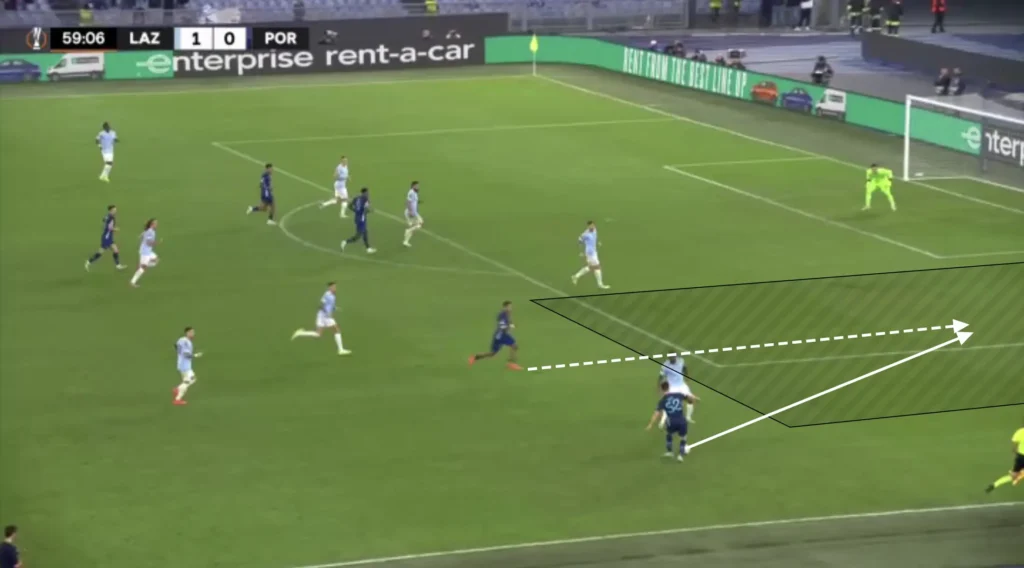

Additionally, the fullback does not have to play the ball to the underlapping player. The run from the Porto attacker will often drag away an opposition defensive midfielder, which opens the space inside. The fullback can take the ball inside and shoot or find a pass to a free player in front of the backline.


Overlaps
Porto have also used overlaps as a key tactic to create goalscoring opportunities under Vítor Bruno. This involves the fullbacks making forward runs to get around their winger, providing an extra attacking option on the flanks. By doing so, they create a 2v1 situation with the winger against the opposition fullback, which could be used to beat the fullback and create crossing opportunities.

Porto’s wingers often initiate the play by attracting the opposition fullback, leaving space for an overlapping fullback to exploit. The overlap forces the defending fullback to make difficult decisions—either stick with the winger or follow the overlapping fullback. If the opposition fullback drops to cover the overlapping run, the winger could cut inside and take a shot or combine with a midfielder. If the fullback covers the center, the ball can easily be played to the overlapping player, creating a crossing opportunity.

Many Players in the Box
Vítor Bruno consistently emphasizes getting multiple players into the box, creating a chaotic environment for the opposition defenders, and increasing their chances of scoring. The attackers and midfielders look to make aggressive runs into the box when the ball is in the final third, often getting four or five players into these areas to create overloads.


The numerical advantages in the box increase the chances of connecting with the cross, as more players present multiple targets for the crosser, making it harder for defenders to mark everyone effectively. Additionally, having multiple players in the box provides options for different types of finishes, whether it’s a header, volley, or a quick tap-in. It also allows for better positioning to react to second balls or rebounds, increasing the likelihood of capitalizing on any defensive errors.
In Porto’s attacking system, the attacking fullbacks score many goals from crosses at the back post. The opposition fullback will often be preoccupied with a Porto attacker, which leaves massive space at the back post for the fullback to attack. The fullback can be found directly or indirectly if no one else connects with the cross.

Bruno also positions many players outside the box, ready for the second balls and cut-backs. Porto will create many crossing opportunities, which pushes down the opposition’s defense and opens the space in front of the opposition’s backline. The holding midfielders can collect any loose balls or be found directly in these spaces with cut-backs, and from there, they can shoot or combine with an attacker to create goalscoring opportunities.
Defending
FC Porto’s base formation when defending is the 1-4-4-2 formation. They look to set up in a mid-block, always trying to close the center and force the opposition out wide.
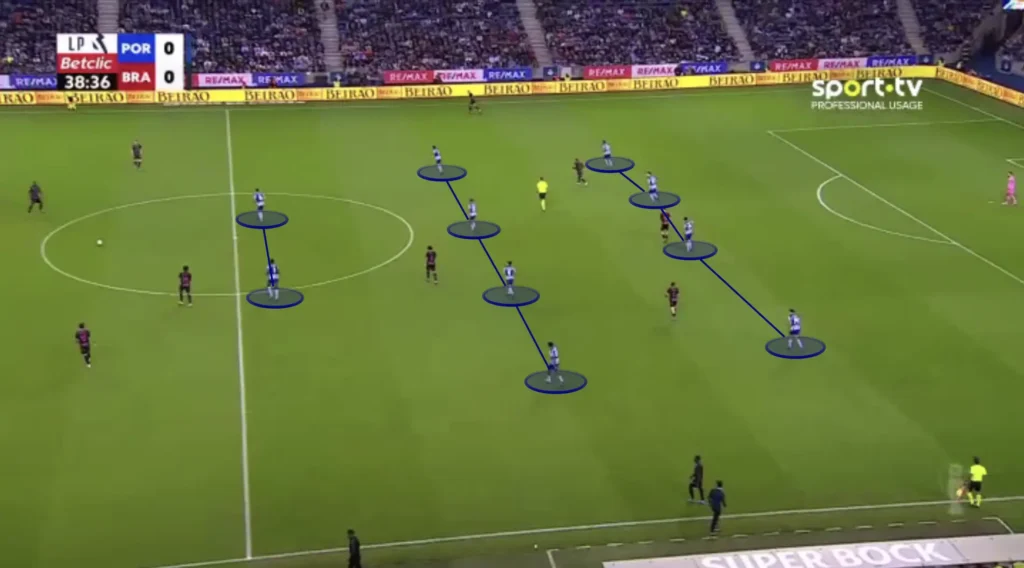

Defending in the 1-4-4-2 formation is all about balance, compactness, and discipline. The team defends in two compact lines of four, with the forwards positioned ahead of the midfield. The two forwards play a crucial role, not only as the first line of defense but also in initiating the team’s pressing strategy. Bruno wants his team to stay compact without dropping too low, preferably closing the space between the midfield and backline.
High Backline
One tool that helps to be compact is to play with a high backline, making the space to the midfield line as small as possible. Bruno’s players do this and usually try to keep the highest line they can without leaving the space behind them too open. Defending with a high backline involves positioning the defensive line closer to the midfield rather than near the goalkeeper. This tactic compresses the space available for the opposing team to operate, disrupting their build-up play and increasing the chances of winning the ball back quickly.

A high backline also allows defenders to support the midfield more effectively, creating numerical superiority in central areas and facilitating quicker transitions from defense to attack. However, it requires defenders with good pace and positional awareness to deal with long balls and prevent opposing attackers from exploiting the space behind. This approach demands constant communication and coordination among the backline to maintain a cohesive and effective defensive structure.
Additionally, everyone must be in the same line when defending with a high backline to maintain an effective offside trap, ensure cohesive coverage, and reduce gaps that attackers can exploit. A well-aligned defensive line makes it easier to catch opposing forwards offside, preventing them from receiving the ball in dangerous positions.
Work Rate
Porto’s work rate when defending is exceptional, defined by relentless energy and discipline. Under Vítor Bruno, the team is organized and compact, with every player contributing to defensive duties. The midfield and forward lines press with intensity, closing down spaces and forcing opponents into uncomfortable positions. Porto’s backline remains focused, consistently tracking runs and maintaining their shape. When a defender breaks out of shape to put pressure on an opposition player, a Porto midfielder will always drop into the backline to cover for his teammate.
They will mainly do this to close the space between the center-back and the fullback. By having a central midfielder step into these gaps, Porto create a back five, allowing them to maintain their defensive shape, prevent overloads, and provide additional cover for their fullbacks, especially when they are pushed out wide.

This compactness ensures that the team stays solid defensively, making it harder for the opposition to break through with wide or central attacks. Additionally, midfielders covering these spaces allow the center-backs to stay in the box in crossing situations.
Squeezing the Pitch
To prevent his team from becoming too low when defending, Vítor Bruno wants his team to squeeze the pitch. This means constantly pushing the team up as much as possible. Every time the opponent plays a slow, sideways pass or a back pass, Porto’s first line of pressure pushes up, with the rest of the team following to stay compact. When the next pass comes, they push up even more, forcing the opponent back even more.


This approach keeps opponents under constant pressure, making it difficult for them to build rhythm or find space between the lines. It also pushes the opponent further away from the Porto goal, making it harder to create chances.
High Press
Porto, under Vítor Bruno, often avoid pressing high up the pitch, preferring to stay compact and organized in a mid or low-block. However, in some games, they have applied high pressure, especially when they spot opportunities to disrupt the opposition’s build-up in key areas. Their pressing structure will depend on the opposition, but they primarily press in either a man-to-man system or a 1-4-1-3-2 formation.
Man-to-Man
Bruno usually wants his team to go man-to-man when pressing the opposition. Each player is assigned a direct opponent to mark tightly, ensuring no easy passing options are available. This intense pressure forces the opposing team into hurried decisions, often resulting in turnovers in dangerous areas. Porto almost use their high press as an attacking threat, scoring many goals from winning the ball high up the pitch.


In a man-to-man system, it becomes crucial that the players know when to mark the opponent they are responsible for and when not to. If an opponent, for example, is very far from the ball, the Porto player marking him does not need to be as close to him. He can instead come in and help create numerical superiorities in the center, decreasing the risk of dangerous 1v1 situations. The Porto players will always have an opposition player they are responsible for. However, they will never be closer to them than they need to be. A rule of thumb for the players could be that the closer you are to the ball, the closer you need to be to your opponent. The further away you are from the ball, the further away you can be from your opponent.
1-4-1-3-2
Porto have also pressed in a 1-4-1-3-2 formation. This pressing system focuses on pushing the opposition out to the side and winning the ball by using the touchline as an “extra” defender.

When the play starts, the strikers will try to close off one opposition center-back by making angled pressing runs, forcing the opposition to one side.

Porto will be aggressive and intensely press to win the ball when it gets played out to one of the opposition fullbacks. The ball-side wide midfielder will push up on the ball-side fullback, with the rest of the midfield shifting across to close down any passing options.
The wide midfielder will press from the inside, closing any passes into the middle. The ball-side striker will try to stop the opposition from switching sides by closing the pass to the ball-side center-back, while the Porto midfielders, who have shifted across, will push up on the opposition midfielders. This gives the opposition fullback very few passing options and often triggers a rushed long ball. The benefit of this pressing system, compared to the man-to-man system, is that it gives the Porto backline a numerical advantage against the opposition attackers, which means they usually win the long balls.
Transitions
Defensive Transitions
Porto are great in defensive transitions. In possession, they always have many players high up and close to the ball, which creates good conditions for counterpressing. Many players close to the ball after losing possession means that many players can work towards regaining possession. Bruno’s players are also very aggressive in the first seconds after losing the ball. The four or five players closest will immediately jump on the opposition player with the ball and close the distance to cut off any passing lanes. This approach disrupts the opponent’s transition from defense to attack, forcing errors and creating opportunities to regain control in dangerous areas.


Counterpressing like this keeps Porto on the front foot, allowing them to dominate possession and create more scoring opportunities. However, it requires exceptional fitness, tactical discipline, and teamwork.
Offensive Transitions
Vítor Bruno also wants his team to counterattack in their offensive transitions. When they win back possession, Porto’s players immediately shift into attack mode, looking to exploit any space left by opponents. Their midfielders, especially the pivots, play a crucial role in initiating quick, vertical passes to the forwards or wide players, who are already positioned to make penetrating runs. This rapid transition is often supported by overlapping fullbacks, providing width and stretching the opposition’s defense. With these quick movements, Porto frequently catches teams off guard, creating high-quality chances before the opponent can regroup defensively. Bruno’s system makes Porto’s counterattacks highly effective, balancing directness with calculated positioning to break through defenses with minimal delay.

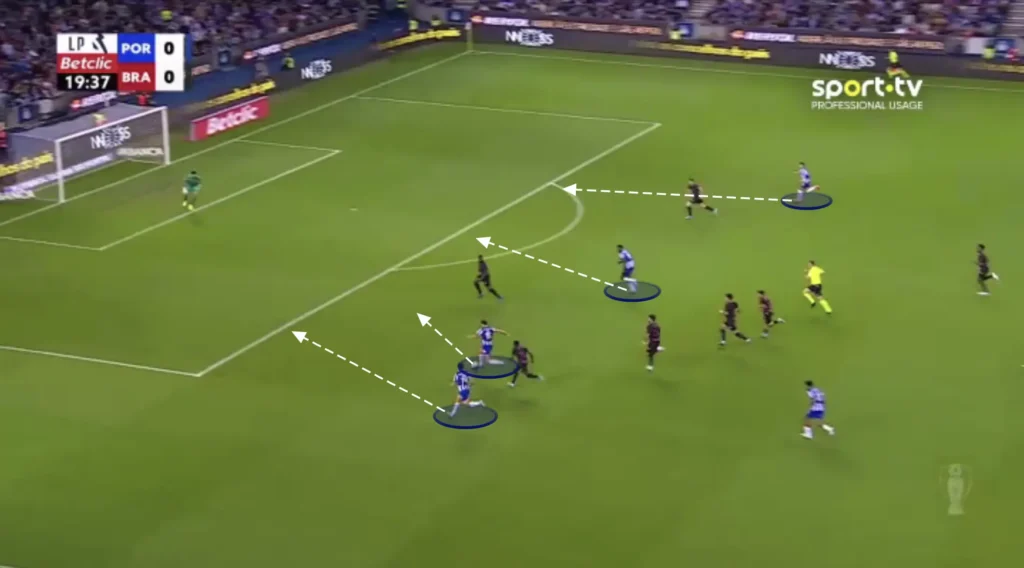
Additionally, Porto try to involve many players in their counterattacks, creating varied options and making it difficult for opponents to predict the next move. This ensures that Porto have plenty of support around the ball and several passing options in transition.
Final Thoughts
In conclusion, Vítor Bruno’s tactical influence at FC Porto is central to their competitive edge and adaptability on the field. His strategic approach combines disciplined defensive structures with fluid, aggressive attacking play, allowing Porto to excel in various phases of the game. By maximizing player roles and utilizing flexible formations, Bruno has crafted a team that is both resilient and versatile.
Through a balance of calculated build-up, pressing, and counterattacking, Porto consistently challenges opponents while maintaining defensive stability. This tactical blueprint not only reflects Vítor Bruno’s footballing insight but also underscores Porto’s ability to stay adaptable and proactive in a demanding league. As FC Porto continues to evolve, Bruno’s tactical innovations will remain key to the team’s success.
